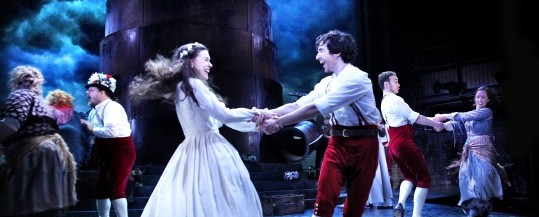Shakespeare’s Wintery Tale
An exuberant display of decadent Persian throws, silk-attired couples languidly smoking shisha pipes and goblets of drink scattered across the stage. This is the opening scene, which characterises the saturnalian beginnings of this season’s RSC adaptation of ‘The Winter’s Tale.’ Lucy Bailey re-envisages this tragicomedy of jealousy and love rekindled in a characteristically high-concept production where the distinction of Shakespeare’s two settings are made by class rather than location.
Bailey has set the story of King Leontes and the consequences of his unfounded jealousy in the 1860s. A pre-Raphaelite Brotherhood live in a sheltered and privileged dream state of Sicilia, from which the fairytale is brought back to a tragic reality. Leontes is suspicious of his wife’s faithfulness to him, and his surging state of jealously is mirrored by the CGI backdrop, which projects increasingly violent rain and stormy seas. Shakespeare’s lack of specification over the cause of Leontes’ jealousy is addressed in this adaption. Leontes is seen to come to the conclusion that Hermione has been unfaithful with more certainty in his soliloquy, and the truth of this is confirmed to the audience as Leontes is joined by a frozen image of Hermione kissing King Polixenes. Maybe it’s a figure of Leontes’ imagination? – the audience could ask. Or an innocent kiss? What if it’s the product of an undeniable sexual attraction between the pair, does that make it wrong? Bailey leaves these questions unanswered.
Throughout the Bohemia scenes (a narrative time of sixteen years), Leontes is trapped in the madness of his jealousy in an ‘ivory tower.’ This is Leontes’ tower of penance – something not dissimilar to Rapunzel’s resting place or where we find Gandalf in The Two Towers. This tower stays throughout the play, retained in both the play’s locations, though transformed into a rusty tower in Bohemia. Is it an industrial chimney? A fairground helter-skelter? Whatever it was, it eventually just felt falsely plonked onto the set.
King Leontes’ childhood friend, King Polixenes, is found occupying the north coast of England during Wakes Week, amongst deck chairs on the beach and Lancashire Morris dancers. Behind, is projected an image of a pier reaching out to sea unbalances the power relationship between Leontes and Polixenes shepherds seem very out of place and the already nonsensical bear seem even more so. And that most famous of stage directions, “Antigonus exits, pursued by a bear” is given a make-shift solution through the using projection of a tsunami – which serves as an absurd metaphor for the fearsome bear.
Ultimately, the use of CGI as orchestrated by designer William Dudley, is a distraction, which rather than contributing to our understanding of the characters or the play, is a little too reminiscent of poor computer graphics in old computer games (think of the sea in Age of Empires). Though the inner torment of the storm is an important feature of Shakespeare’s play, with pathetic fallacy that is reminiscent of King Lear, attempting to capture this realistically comes across as amateur. This felt jarring to the ‘tale’ whose resting memory ought to be the wondrously magically (if unbelievably fortuitous) ending.
The saving grace of the production is Tara Fitzgerald’s brilliant debut performance with the RSC ensemble, who is seen amongst a united and highly entertaining cast. Hermione is one of Shakespeare’s most strong willed female protagonists and Fitzgerald resolutely carries the weight of her speeches, particularly in her defence at the trial. Her voice is unexpectedly deep and husky, making the first lines of her statue’s magic resurrection even more surprising. Paulina was played so fiercely and shrewishly by Rakie Ayola that Leontes comically flees from her onslaught of words.
Pearce Quigley reigns as the comic highlight of the show playing an Irish Autolycus, with a dry and facetiously camp humour that is deadpan almost to the point of parody. His opportunistic cut-purse activity only by the audience, makes his victims farcical.
If you can look past the short-comings of the set and artistic vision of the production, Fitzgerald’s feisty Hermione and Quigley’s Autolycus are entertaining enough to make ‘The Winter’s Tale’ worth seeing.
The Winter’s Tale is showing until 23 February at the RSC, then touring. Tickets can be purchased at www.rsc.org.uk

Comments